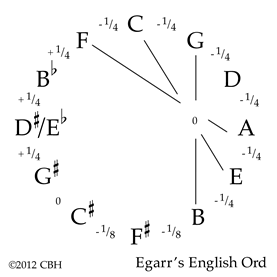Technical Library
TEMPERAMENTS XIV: Egarr’s English Ord
Entire Contents Copyright © 2020 CBHTechnical LibraryTEMPERAMENTS XIV: Egarr’s English Ord Entire Contents Copyright © 2020 CBH |

The so-called “Ord” temperaments are modified meantones and provide a usable spread of keys with good color. The name might be explained by the variations in this temperament stream being the common or “ordinary” tuning method in England, like the phrase tempérament ordinaire in French. In his 2007 book The Temperament of Keyboard Music — Its Character; its Musicality; and its History, the late Alexander Mackenzie of Ord found his own invention the most perfect temperament of all—reinforced no doubt by the coincidence of his matching name.
For some time, the English harpsichordist and director of Academy of Ancient Music, Richard Egarr, has nicknamed the version he uses “Stinky Tone”, and specified it for most of the program of his eleven-concert October 2012 tour with Australian Chamber Orchestra playing Corelli, Castello, Biber, Avison and Handel. Great for music of the seventeenth-century, its blatant and spicy flavor can also be appreciated in later music. Dissonance comes early in the tonal wanderings, so orchestral players must keep on their toes. For example, the wonderful e minor tonic makes an ideal resolution from its harsh B Major dominant chord.
The natural keys are the same as your usual Quarter-comma Meantone, so three pure Major thirds are retained. The D♯/E♭ is split and symmetrical to provide a suitably-compromized Major third above both E♭ and B—the same position as our Split-wolf Meantone. The three fifths on the flat side of F are a quarter-comma wide, and the fifths made between other true sharp keys are either slightly narrow or pure.
 Try this temperament by modifying your usual Quarter-comma Meantone as follows:
Try this temperament by modifying your usual Quarter-comma Meantone as follows:
1. Begin by determining your D♯/E♭ compromize. You must sharpen your d♯ which was initially found a pure third up from B, until in your opinion both the Major thirds from B–d♯ and d♯ (really e♭)–g are usable, although both rapidly beating.
2. Split the difference between E♭ and F, placing your B♭ midway. This gives you two quarter-comma fifths, rapidly beating but wide rather than narrow like those fifths between all the natural keys.
3. To determine the three sharp keys, work from your Meantone f♯ which is a pure third above d—although you will move the f♯ afterwards. Your permanent c♯' is found a pure fifth above the f♯, then tune down an octave to c♯ and a pure fifth up to permanently place your g♯.
4. Finally, split the difference between B and C♯, placing your F♯ midway. Raise the f♯ slightly, comparing how it fares in the fifths it makes with both c♯' above and B below. Both fifths need a slow wave. Being higher up the keyboard, you don’t need me to remind you that the fifth f♯–c♯' must beat more rapidly than B–f♯ for us to consider them the same theoretical size of eighth-comma narrow fifths shown in the diagram.
Spicy enough? For something more gruesome, try Third-comma Meantone.
Further discussion
Mackenzie of Ord, ACN The Temperament of Keyboard Music — Its Character; its Musicality; and its History Bristol 2007
| Pitch nomenclature | |
| Harpsichord Tuning Process | |
| Tuning Bibliography | |
| Technical Library overview | |
| Harpsichords Australia Home Page |